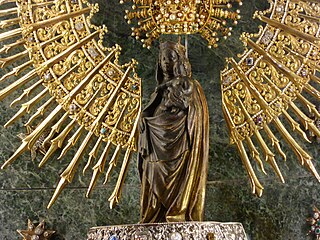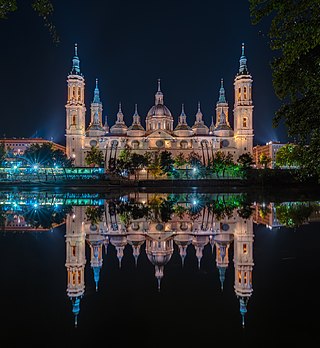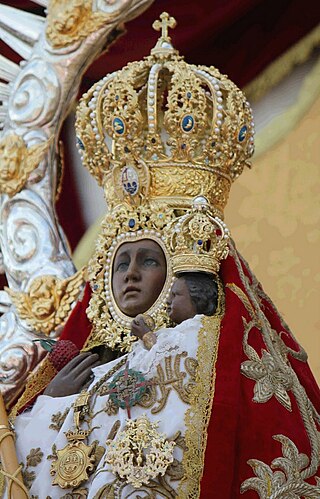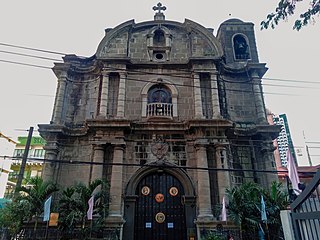
Our Lady of the Pillar is the name given to the Blessed Virgin Mary in the context of the traditional belief that Mary, while living in Jerusalem, supernaturally appeared to the Apostle James the Greater in AD 40 while he was preaching in what is now Spain. Those who adhere to this belief consider this appearance to be the only recorded instance of Mary exhibiting the mystical phenomenon of bilocation. Among Catholics, it is also considered the first Marian apparition, and unique because it happened while Mary was still living on Earth.

Motril is a town and municipality of Spain belonging to the province of Granada, in the autonomous community of Andalusia.

The Cathedral-Basilica of Our Lady of the Pillar is a Catholic church in the city of Zaragoza, Aragon. It is dedicated to the Blessed Virgin Mary under the title of Our Lady of the Pillar, praised as "Mother of the Hispanic Peoples" by Pope John Paul II. It is reputed to be the first-ever church dedicated to Mary.

Candelaria, also Villa Mariana de Candelaria, is a municipality and city in the eastern part of the island of Tenerife in the Province of Santa Cruz de Tenerife, in the Canary Islands, Spain. The city is located on the coast, 17 km southwest of Santa Cruz de Tenerife. The population is 25,140 (2010), and the area is 49.18 km².

The Basilica of Our Lady of Zapopan and the abbey of the same name are a 17th-century Franciscan sanctuary built in downtown Zapopan, in the state of Jalisco, México.

The Diocese of San Pablo is a Roman Catholic diocese which is a suffragan of the Archdiocese of Manila. Its patron saint or titular is Paul the First Hermit, the only one in the world dedicated to him.

The Virgin of Candelaria or Our Lady of Candle (Tagalog: Mahal na Birhen ng Candelaria, popularly called La Morenita, celebrates the Virgin Mary on the island of Tenerife, one of the Canary Islands. The center of worship is located in the city of Candelaria in Tenerife. She is depicted as a Black Madonna. The "Royal Basilica Marian Shrine of Our Lady of Candelaria" is considered the main church dedicated to the Virgin Mary in the Canary Islands and she is the patroness saint of the Canary Islands. Her feast is celebrated on February 2 and August 15, the patronal feast of the Canary Islands.
Saint Indaletius is venerated as the patron saint of Almería, Spain. Tradition makes him a Christian missionary of the 1st century, during the Apostolic Age. He evangelized the town of Urci, near the present-day city of Almería, and became its first bishop. He may have been martyred at Urci.

According to Christian tradition, the Seven Apostolic Men were seven Christian clerics ordained in Rome by Saints Peter and Paul and sent to evangelize Spain. This group includes Torquatus, Caecilius, Ctesiphon, Euphrasius, Indaletius, Hesychius, and Secundius.

Saint Torquatus is venerated as the patron saint of Guadix, Spain. Tradition makes him a Christian missionary of the 1st century, during the Apostolic Age. He evangelized the town of Acci, identified as Guadix, and became its first bishop.

Saint Caecilius is venerated as the patron saint of Granada, Spain.

Saint Secundus or Secundius is venerated as a Christian missionary and martyr of the 1st century, during the Apostolic Age. He evangelized the town of Abula, which has been identified as either Abla or Ávila, and became its first bishop.
Urci was an ancient settlement in southeastern Roman Hispania mentioned by Pomponius Mela, Pliny the Elder, and Claudius Ptolemy. The writings of these historians indicate that the city was located in the hinterland of what is now Villaricos, Spain, in the lower basin of the Almanzora River. Some modern encyclopedias and historians have wrongly located Urci at Pechina, El Chuche or the City of Almería.

The Cathedral of San Cristóbal de La Laguna or Catedral de Nuestra Señora de los Remedios is a Roman Catholic church in Tenerife, Spain. Constructed between 1904 and 1915 to replace an earlier building begun in 1515 and designated a cathedral in 1818, it is dedicated to the Virgin of Los Remedios. The cathedral is the mother church of the diocese, which includes the islands of Tenerife, La Palma, La Gomera and El Hierro in the province of Santa Cruz de Tenerife. It is therefore where the episcopal seat of the bishop of this diocese, which is currently vacant following the 2024 retirement of Bishop Bernardo Álvarez Afonso. This is one of the most important churches of the Canary Islands.

Our Lady of Europe is a title given to the Blessed Virgin Mary as patroness of Gibraltar and protectress of Europe. The entire European continent was consecrated under the protection of Our Lady of Europe in the early 14th century from the Shrine in Gibraltar where devotion continues to this day, over 700 years on.

Saint Euphrasius of Illiturgis is venerated as a Christian missionary of the 1st century, during the Apostolic Age. Euphrasius’ diocese was traditionally associated with Illiturgis (Iliturgi), located between Bailén and Andújar. He is said to have been martyred at Illiturgis. According to tradition, he is one of the group of Seven Apostolic Men, seven Christian clerics ordained in Rome by Saints Peter and Paul and sent to evangelize Spain. Besides Euphrasius, this group includes Sts. Hesychius, Ctesiphon, Torquatus, Indaletius, and Secundius.

Our Lady of Cabeza is a Marian apparition and statue of the Madonna and Child, whose cult is centered at the Basilica of Nuestra Señora de la Cabeza, located in the Natural Park of the Sierra of Andújar, 32 km north of the city of Andújar, Spain. A Black Madonna, she is known popularly as La Morenita.

The Our Lady of Guidance is a title of the Blessed Virgin Mary associated with a 16th-century Marian image depicted as the Immaculate Conception and widely venerated by Filipinos. The wooden Black Madonna is considered the oldest extant Marian statue in the Philippines. Locally venerated as patroness of navigators and travelers, the image is enshrined at the Ermita Church in the city of Manila.

Saints Peter and Paul Parish Church, also known as San Pedro Macati Church, Sampiro Church, Makati Church, is a Roman Catholic church located in Makati Poblacion, the cultural and heritage barangay of Makati, Philippines. It is under the jurisdiction of the Archdiocese of Manila. In front of the church facade is Plaza Cristo Rey, which was formerly the San Pedro de Macati Cemetery. The National Museum of the Philippines designated the church an Important Cultural Property in 2023.

Our Lady of Consolation or Mary, Comforter of the Afflicted is a title of the Blessed Virgin Mary venerated in the Catholic Church.


















